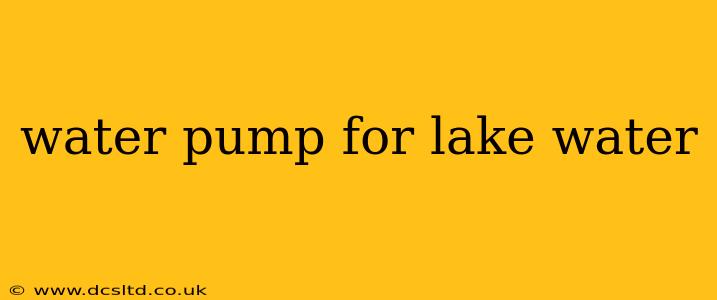Drawing water from a lake for various purposes requires a specific type of pump, capable of handling the unique challenges presented by this water source. This guide will help you navigate the complexities of selecting the ideal water pump for your lake, addressing common concerns and providing expert advice. Whether you need a pump for irrigation, a water feature, or another application, understanding your needs is the first critical step.
What are the different types of water pumps suitable for lake water?
Several pump types excel at handling lake water, each with its strengths and weaknesses. The best choice depends heavily on your specific needs, including the volume of water required, the distance the water needs to be pumped, and the presence of debris or sediment. Common choices include:
- Submersible Pumps: These pumps are placed directly into the lake water. They are excellent for handling large volumes of water and are less prone to issues with airlocks. However, they require careful consideration of depth and potential damage from debris.
- Centrifugal Pumps: These pumps are generally located on the shore and draw water from the lake using a suction pipe. They're adaptable to various flow rates and pressures. However, they are more susceptible to airlocks and require a priming system to initially fill the pump with water.
- Diaphragm Pumps: Known for their ability to handle thicker liquids and materials with suspended solids, these pumps are ideal if your lake water contains significant sediment or debris. However, they typically have lower flow rates compared to other options.
What factors should I consider when choosing a lake water pump?
Selecting the right pump requires careful consideration of several factors:
- Water flow rate (GPM): This indicates the volume of water the pump can move per minute. Consider your application's water demand; insufficient flow rate can lead to inefficient operation.
- Water pressure (PSI): Pressure determines how far the water can be pumped and the height it can reach. Higher pressure is needed for long distances or significant elevation changes.
- Pump head: This represents the total vertical distance the pump lifts the water, including any horizontal distance due to friction losses in the piping.
- Intake size: The intake diameter directly impacts the water flow rate. Larger intakes are generally preferred for high-volume applications.
- Power source: Pumps can operate on electricity (AC or DC) or gas. Consider availability, cost, and environmental factors.
- Debris handling: If the lake water contains debris, a pump with robust construction and features that minimize clogging is crucial.
- Maintenance: Evaluate the ease of maintenance and the availability of replacement parts.
How do I prevent my lake water pump from clogging?
Clogging is a common issue with lake water pumps. To prevent this, consider these strategies:
- Use a suitable pump: Diaphragm pumps are specifically designed to handle thicker liquids and sediment.
- Install a filter: A pre-filter at the pump intake will trap larger debris, preventing clogging.
- Regular maintenance: Periodically inspect and clean the pump, removing any accumulated sediment.
- Proper placement: Avoid placing the intake near areas with high sediment concentrations.
What is the best type of pump for irrigating my garden with lake water?
For garden irrigation, a centrifugal pump is often a good choice due to its ability to handle moderate flow rates and pressures. However, if your lake water contains considerable sediment, a diaphragm pump might be more suitable. Consider the distance from the lake to your garden when determining the required pump pressure and head.
How much does a lake water pump cost?
The cost of a lake water pump varies widely based on its size, features, and brand. Prices can range from a few hundred dollars for smaller, less powerful pumps to several thousand dollars for large, heavy-duty models.
How do I maintain my lake water pump?
Regular maintenance is vital for extending the lifespan of your lake water pump. This typically involves periodic inspections, cleaning, and lubricant changes as recommended by the manufacturer's instructions. Early detection and resolution of any issues can prevent costly repairs or replacements.
This guide provides a foundation for selecting the right water pump for your lake. Always consult with a pump specialist to receive personalized recommendations based on your specific needs and the characteristics of your water source. Remember, proper planning and maintenance are crucial for ensuring long-term efficiency and reliability.
